| Listing 1 - 10 of 10 |
Sort by
|
Book
ISBN: 1282760475 9786612760471 981283446X Year: 2010 Publisher: Singapore : World Scientific,
Abstract | Keywords | Export | Availability | Bookmark
 Loading...
Loading...Choose an application
- Reference Manager
- EndNote
- RefWorks (Direct export to RefWorks)
This book is a collection of scientific papers published during the last five years, showing a broad spectrum of actual research topics and techniques used to solve challenging problems in the areas of computer vision and image analysis. The book will appeal to researchers, technicians and graduate students. Sample Chapter(s)
Chapter 1: An Appearance-Based Method for Parametric Video Registration (2,352 KB)
Contents:
- An Appearance-Based Method for Parametric Video Registration (X Orriols et al.)
- Relevance of Multifractal Textures in Static Imag
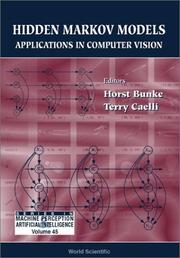
ISBN: 9812797602 9789812797605 9789810245641 9810245645 Year: 2001 Publisher: Singapore River Edge, NJ World Scientific
Abstract | Keywords | Export | Availability | Bookmark
 Loading...
Loading...Choose an application
- Reference Manager
- EndNote
- RefWorks (Direct export to RefWorks)
Hidden Markov models (HMMs) originally emerged in the domain of speech recognition. In recent years, they have attracted growing interest in the area of computer vision as well. This book is a collection of articles on new developments in the theory of HMMs and their application in computer vision. It addresses topics such as handwriting recognition, shape recognition, face and gesture recognition, tracking, and image database retrieval.This book is also published as a special issue of the International Journal of Pattern Recognition and Artificial Intelligence (February 2001).
Computer vision --- Optical pattern recognition --- Markov processes. --- Analysis, Markov --- Chains, Markov --- Markoff processes --- Markov analysis --- Markov chains --- Markov models --- Models, Markov --- Processes, Markov --- Stochastic processes --- Optical data processing --- Pattern perception --- Perceptrons --- Visual discrimination --- Machine vision --- Vision, Computer --- Artificial intelligence --- Image processing --- Pattern recognition systems --- Mathematical models.

ISBN: 9812778144 9789812778147 9789810248321 9789812778147 9810248326 Year: 2002 Publisher: River Edge, N.J. World Scientific
Abstract | Keywords | Export | Availability | Bookmark
 Loading...
Loading...Choose an application
- Reference Manager
- EndNote
- RefWorks (Direct export to RefWorks)
The field of pattern recognition has seen enormous progress since its beginnings almost 50 years ago. A large number of different approaches have been proposed. Hybrid methods aim at combining the advantages of different paradigms within a single system. Hybrid Methods in Pattern Recognition is a collection of articles describing recent progress in this emerging field. It covers topics such as the combination of neural nets with fuzzy systems or hidden Markov models, neural networks for the processing of symbolic data structures, hybrid methods in data mining, the combination of symbo
Pattern recognition systems. --- Neural networks (Computer science) --- Artificial neural networks --- Nets, Neural (Computer science) --- Networks, Neural (Computer science) --- Neural nets (Computer science) --- Artificial intelligence --- Natural computation --- Soft computing --- Pattern classification systems --- Pattern recognition computers --- Pattern perception --- Computer vision
Book
ISBN: 981281454X 9789812814548 9812814531 9789812814531 Year: 2008 Publisher: Singapore Hackensack, NJ World Scientific
Abstract | Keywords | Export | Availability | Bookmark
 Loading...
Loading...Choose an application
- Reference Manager
- EndNote
- RefWorks (Direct export to RefWorks)
This book addresses the task of processing online handwritten notes acquired from an electronic whiteboard, which is a new modality in handwriting recognition research. The main motivation of this book is smart meeting rooms, aim to automate standard tasks usually performed by humans in a meeting.The book can be summarized as follows. A new online handwritten database is compiled, and four handwriting recognition systems are developed. Moreover, novel preprocessing and normalization strategies are designed especially for whiteboard notes and a new neural network based recognizer is applied. Co
Optical pattern recognition. --- Writing --- Interactive whiteboards. --- Image processing --- Optical data processing --- Pattern perception --- Perceptrons --- Visual discrimination --- Digital image processing --- Digital electronics --- Computer input-output equipment --- Whiteboards --- Chirography --- Handwriting --- Language and languages --- Ciphers --- Penmanship --- Data processing. --- Digital techniques.
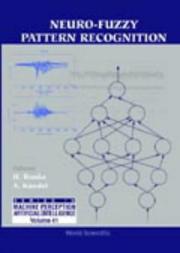
ISBN: 9812792201 9789812792204 9810244185 9789810244187 Year: 2000 Publisher: Singapore River Edge, N.J. World Scientific
Abstract | Keywords | Export | Availability | Bookmark
 Loading...
Loading...Choose an application
- Reference Manager
- EndNote
- RefWorks (Direct export to RefWorks)
Neural networks and fuzzy techniques are among the most promising approaches to pattern recognition. Neuro-fuzzy systems aim at combining the advantages of the two paradigms. This book is a collection of papers describing state-of-the-art work in this emerging field. It covers topics such as feature selection, classification, classifier training, and clustering. Also included are applications of neuro-fuzzy systems in speech recognition, land mine detection, medical image analysis, and autonomous vehicle control. The intended audience includes graduate students in computer science and related fields, as well as researchers at academic institutions and in industry.
Pattern recognition systems. --- Fuzzy systems. --- Neural networks (Computer science) --- Artificial neural networks --- Nets, Neural (Computer science) --- Networks, Neural (Computer science) --- Neural nets (Computer science) --- Artificial intelligence --- Natural computation --- Soft computing --- Systems, Fuzzy --- System analysis --- Fuzzy logic --- Pattern classification systems --- Pattern recognition computers --- Pattern perception --- Computer vision --- Fuzzy systems --- Pattern recognition systems --- 681.3*I51 --- 681.3*I51 Models: deterministic; fuzzy set; geometric; statistical; structural (Patternrecognition) --- Models: deterministic; fuzzy set; geometric; statistical; structural (Patternrecognition)
Book
ISBN: 1283144506 9786613144508 9814304727 9789814304726 9781283144506 9789814304719 9814304719 6613144509 Year: 2010 Publisher: Singapore London World Scientific
Abstract | Keywords | Export | Availability | Bookmark
 Loading...
Loading...Choose an application
- Reference Manager
- EndNote
- RefWorks (Direct export to RefWorks)
This book is concerned with a fundamentally novel approach to graph-based pattern recognition based on vector space embedding of graphs. It aims at condensing the high representational power of graphs into a computationally efficient and mathematically convenient feature vector. This volume utilizes the dissimilarity space representation originally proposed by Duin and Pekalska to embed graphs in real vector spaces. Such an embedding gives one access to all algorithms developed in the past for feature vectors, which has been the predominant representation formalism in pattern recognition and r
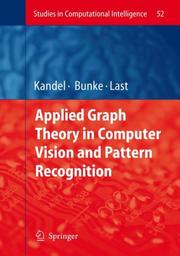
ISBN: 9783540680192 3540680195 9786610853052 1280853050 3540680209 Year: 2007 Volume: 52 Publisher: Berlin, Germany ; New York, United States : Springer,
Abstract | Keywords | Export | Availability | Bookmark
 Loading...
Loading...Choose an application
- Reference Manager
- EndNote
- RefWorks (Direct export to RefWorks)
This book will serve as a foundation for a variety of useful applications of graph theory to computer vision, pattern recognition, and related areas. It covers a representative set of novel graph-theoretic methods for complex computer vision and pattern recognition tasks. The first part of the book presents the application of graph theory to low-level processing of digital images such as a new method for partitioning a given image into a hierarchy of homogeneous areas using graph pyramids, or a study of the relationship between graph theory and digital topology. Part II presents graph-theoretic learning algorithms for high-level computer vision and pattern recognition applications, including a survey of graph based methodologies for pattern recognition and computer vision, a presentation of a series of computationally efficient algorithms for testing graph isomorphism and related graph matching tasks in pattern recognition and a new graph distance measure to be used for solving graph matching problems. Finally, Part III provides detailed descriptions of several applications of graph-based methods to real-world pattern recognition tasks. It includes a critical review of the main graph-based and structural methods for fingerprint classification, a new method to visualize time series of graphs, and potential applications in computer network monitoring and abnormal event detection.
Computer vision --- Pattern recognition systems --- Graph theory --- Vision par ordinateur --- Reconnaissance des formes (Informatique) --- Théorie des graphes --- Graphic methods --- Méthodes graphiques --- Computer vision -- Graphic methods. --- Electronic books. -- local. --- Graph theory. --- Pattern recognition systems -- Graphic methods. --- Engineering & Applied Sciences --- Civil & Environmental Engineering --- Applied Mathematics --- Civil Engineering --- Applied Physics --- Graphic methods. --- Théorie des graphes --- Méthodes graphiques --- EPUB-LIV-FT SPRINGER-B --- Graphs, Theory of --- Theory of graphs --- Pattern classification systems --- Pattern recognition computers --- Machine vision --- Vision, Computer --- Extremal problems --- Engineering. --- Artificial intelligence. --- Applied mathematics. --- Engineering mathematics. --- Appl.Mathematics/Computational Methods of Engineering. --- Artificial Intelligence (incl. Robotics). --- Combinatorial analysis --- Topology --- Pattern perception --- Artificial intelligence --- Image processing --- Mathematical and Computational Engineering. --- Artificial Intelligence. --- AI (Artificial intelligence) --- Artificial thinking --- Electronic brains --- Intellectronics --- Intelligence, Artificial --- Intelligent machines --- Machine intelligence --- Thinking, Artificial --- Bionics --- Cognitive science --- Digital computer simulation --- Electronic data processing --- Logic machines --- Machine theory --- Self-organizing systems --- Simulation methods --- Fifth generation computers --- Neural computers --- Engineering --- Engineering analysis --- Mathematical analysis --- Mathematics
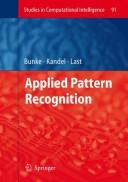
ISBN: 9783540768302 3540768300 3540768319 Year: 2008 Volume: 91 Publisher: Berlin, Germany ; New York, New York : Springer-Verlag,
Abstract | Keywords | Export | Availability | Bookmark
 Loading...
Loading...Choose an application
- Reference Manager
- EndNote
- RefWorks (Direct export to RefWorks)
A sharp increase in the computing power of modern computers, accompanied by a decrease in the data storage costs, has triggered the development of extremely powerful algorithms that can analyze complex patterns in large amounts of data within a very short period of time. Consequently, it has become possible to apply pattern recognition techniques to new tasks characterized by tight real-time requirements (e.g., person identification) and/or high complexity of raw data (e.g., clustering trajectories of mobile objects). The main goal of this book is to cover some of the latest application domains of pattern recognition while presenting novel techniques that have been developed or customized in those domains.
Pattern recognition systems --- Computer vision --- Reconnaissance des formes (Informatique) --- Vision par ordinateur --- Civil Engineering --- Electrical Engineering --- Applied Mathematics --- Engineering & Applied Sciences --- Civil & Environmental Engineering --- Electrical & Computer Engineering --- Computer vision. --- Pattern recognition systems. --- Pattern classification systems --- Pattern recognition computers --- Machine vision --- Vision, Computer --- Engineering. --- Artificial intelligence. --- Computer graphics. --- Pattern recognition. --- Applied mathematics. --- Engineering mathematics. --- Appl.Mathematics/Computational Methods of Engineering. --- Pattern Recognition. --- Artificial Intelligence (incl. Robotics). --- Computer Imaging, Vision, Pattern Recognition and Graphics. --- Applications of Mathematics. --- Pattern perception --- Artificial intelligence --- Image processing --- Optical pattern recognition. --- Mathematics. --- Mathematical and Computational Engineering. --- Artificial Intelligence. --- Math --- Science --- AI (Artificial intelligence) --- Artificial thinking --- Electronic brains --- Intellectronics --- Intelligence, Artificial --- Intelligent machines --- Machine intelligence --- Thinking, Artificial --- Bionics --- Cognitive science --- Digital computer simulation --- Electronic data processing --- Logic machines --- Machine theory --- Self-organizing systems --- Simulation methods --- Fifth generation computers --- Neural computers --- Optical data processing --- Perceptrons --- Visual discrimination --- Engineering --- Engineering analysis --- Mathematical analysis --- Mathematics --- Optical data processing. --- Optical computing --- Visual data processing --- Integrated optics --- Photonics --- Computers --- Design perception --- Pattern recognition --- Form perception --- Perception --- Figure-ground perception --- Optical equipment
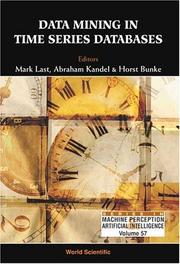
ISBN: 1281347760 9786611347765 981256540X 1423723023 9781423723028 9789812382900 9812382909 9781281347763 Year: 2004 Volume: 57 Publisher: New Jersey ; London : World Scientific,
Abstract | Keywords | Export | Availability | Bookmark
 Loading...
Loading...Choose an application
- Reference Manager
- EndNote
- RefWorks (Direct export to RefWorks)
Adding the time dimension to real-world databases produces Time SeriesDatabases (TSDB) and introduces new aspects and difficulties to datamining and knowledge discovery. This book covers the state-of-the-artmethodology for mining time series databases. The novel data miningmethods presented in the book include techniques for efficientsegmentation, indexing, and classification of noisy and dynamic timeseries. A graph-based method for anomaly detection in time series isdescribed and the book also studies the implications of a novel andpotentially useful representation of time series as strings.
Data mining. --- Distributed databases. --- Distributed data bases --- Distributed database systems --- Databases --- Cyberinfrastructure --- Algorithmic knowledge discovery --- Factual data analysis --- KDD (Information retrieval) --- Knowledge discovery in data --- Knowledge discovery in databases --- Mining, Data --- Database searching --- Data mining --- Exploration de données (Informatique) --- Bases de données réparties
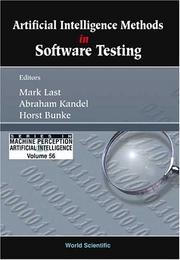
ISBN: 128193464X 9786611934644 9812794751 9789812794758 9789812388544 9812388540 9812388540 Year: 2004 Publisher: Singapore River Edge, NJ World Scientific
Abstract | Keywords | Export | Availability | Bookmark
 Loading...
Loading...Choose an application
- Reference Manager
- EndNote
- RefWorks (Direct export to RefWorks)
An inadequate infrastructure for software testing is causing major losses to the world economy. The characteristics of software quality problems are quite similar to other tasks successfully tackled by artificial intelligence techniques. The aims of this book are to present state-of-the-art applications of artificial intelligence and data mining methods to quality assurance of complex software systems, and to encourage further research in this important and challenging area.
Contents:
- Fuzzy Cause-Effect Models of Software Testing (W Pedrycz & G Vukovich)
- Black
Computer software --- Artificial intelligence. --- AI (Artificial intelligence) --- Artificial thinking --- Electronic brains --- Intellectronics --- Intelligence, Artificial --- Intelligent machines --- Machine intelligence --- Thinking, Artificial --- Bionics --- Cognitive science --- Digital computer simulation --- Electronic data processing --- Logic machines --- Machine theory --- Self-organizing systems --- Simulation methods --- Fifth generation computers --- Neural computers --- Software, Computer --- Computer systems --- Testing. --- Quality control.
| Listing 1 - 10 of 10 |
Sort by
|

 Search
Search Feedback
Feedback About UniCat
About UniCat  Help
Help News
News